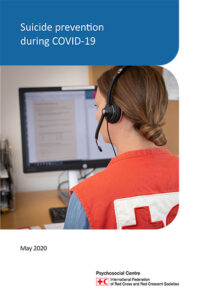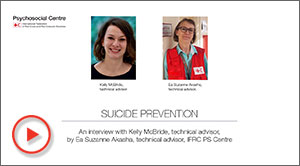An interview with Mental Health and Psychosocial Support Technical Advisor, Kelly McBride
COVID-19 has triggered and intensified a wide range of mental health problems, with both immediate and potentially long-term impacts. Several factors could catalyze the risk for suicide such as increased social isolation and feelings of loneliness, job loss and economic disruptions, uncertainty, hopelessness and depression. Individuals might be more at risk of substance use disorders or experience and increase of violence in their lives. These are all examples of risk factors for suicide that tell us that suicide rates will possibly increase due to the challenges of the global pandemic.
Kelly McBride, Mental Health and Psychosocial Support Technical Advisor for the PS Centre and author of “Suicide prevention during COVID-19,” explains the possible rise in numbers of suicide cases in the context of the pandemic:
“We have to take our mental health and well-being seriously, and we have to be prepared for a possible increase in suicide. There is no way of telling. I don’t think that we have the data yet to really understand if the trends are saying there is an increase in numbers. But what’s most important is that we’re prepared and we’re doing things to be preventative so that we don’t see a spike.”
Staff and volunteers with adequate knowledge and preparation on managing suicide and harm prevention is therefore crucial and should be included in all programming. McBride describes the simultaneous importance of implementing appropriate suicide prevention responses, while ensuring the safety and well-being of staff and volunteers. She highlights the need for access to training and ongoing supportive supervision for staff and volunteers to identify those at risk and respond appropriately, while being supported throughout the process.
According to McBride, suicide can often be stigmatized at the individual, community or systematic level, where it is either socially shunned or in some cases even criminalized. This can evoke feelings of shame and hopelessness, and thereby stops people with suicidal thoughts from reaching out for help.
“Talking about self-harm, talking about suicide, talking about suicidal thoughts, all can be really helpful in finding ways to support that individual and ultimately prevent suicide from occurring.”
The misuse of language around the topic of suicide has created certain barriers for individuals to reach out for help. Utilizing appropriate language to debunk the stigma is therefore an integral part of the prevention strategy.
“One of the common terms that we hear is to ‘commit suicide.’ To ‘commit,’ has connotations that you have committed a crime. If we think about that, it really helps us to illustrate what stigma can look like and can serve as barriers for people reaching out to get help.”
Language such as ‘taking their own life’, and ‘died by suicide ‘ have been found to be most accepted among those affected by suicide. McBride also emphasizes the importance of creating a supportive and safe environment where the affected individual is comfortable to share their thoughts without feeling judged by the listener. If an individual expresses the desire to harm themselves, staff and volunteers must stay calm and normalize the person’s feelings and thoughts of distress. To create a safe space for this individual they must be able to communicate empathetically, communicate with concern, use active listening skills and manage emotional reactions. It is particularly important during the COVID-19 response to convey non-judgement, patience and empathy as many of these conversations occur remotely.
While staff and volunteers who have been trained play a vital role in providing support and managing risk, McBride also underlined the importance of psychoeducation for family and friends of those at risk. With a base knowledge of how to support those with thoughts of suicide, family and friends may have a fundamental impact on individuals who are at risk. Psychoeducation teaches these individuals about the warning signs, what to do if they arise, how to effectively listen and how to create a safe and supportive space for their loved ones at risk. Friends and family may encounter challenges due to the significant stigma and misinformation around suicide, often leaving them feeling overwhelmed.
“What is really important in psychoeducation is to help loved ones and people close to that individual understand those different types of warning signs and things they should be looking out for in their loved ones. They would know how to support them, in particularly when it’s time to seek external help.”
The stigmatization of suicide has created a barrier that limits the level of support those in need. A variety of risk factors that potentially lead to suicide have already been identified throughout this pandemic. It is vital to implement preventative strategies that prepares and supports staff and volunteers to act appropriately while maintaining their own well-being, and ultimately saving the lives of those at risk. Family and friends of the affected individuals may also have a significant influence to support their loved ones and break down the barriers of external stigma.
“A key thing that can be done is establishing support groups in communities. Unfortunately, we notice that if there are suicides occurring, then there is a bit of a spike and it becomes a bit of a trend. Creating support groups within communities, connecting those impacted by suicide with each other, with social groups and with support groups are key ways to help them heal from this, if and when it does happen.”


